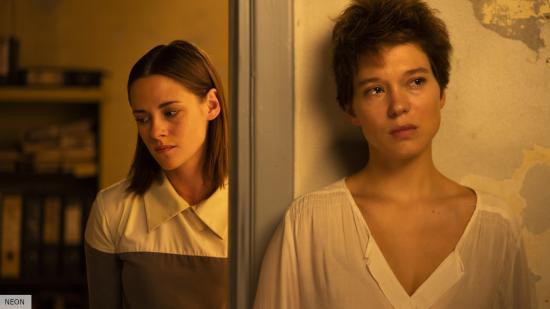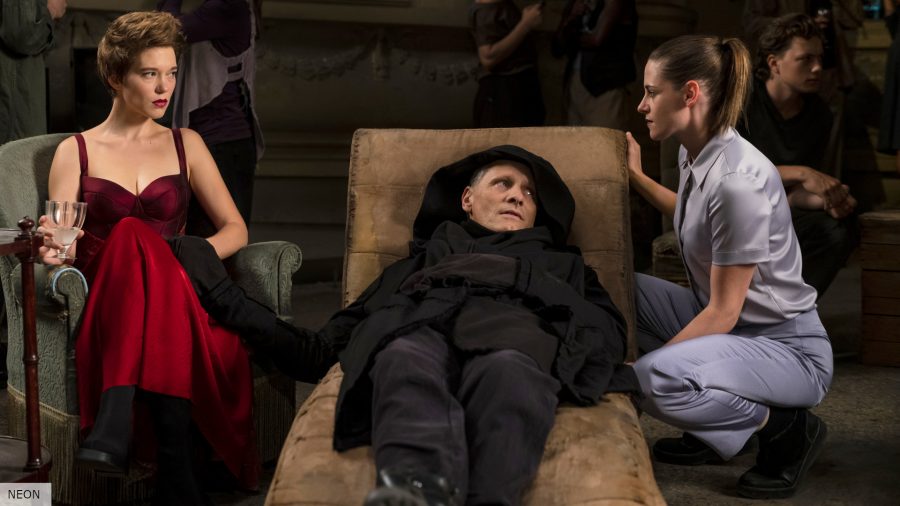Our Verdict
Crimes of the Future is another gross-out and genuinely erotic feature from Cronenberg that's a Wholly original slice of sicko-fare.
From the capillary-red opening credits that thud with Howard Shore’s excellent score to the chef’s-kiss ending that leaves you floating out of your chair, Crimes of the Future is yet another gross-out and genuinely erotic feat from the one and only David Cronenberg.
“I’ve often thought that there should be beauty contests for the insides of bodies,” says gynaecologist Elliott Mantle in David Cronenberg’s Dead Ringers, a film that ends with the disembowelment of one’s flesh – a pessimistic acceptance that human hubris is out of sync with the capabilities of our bodies.
Crimes of the Future, then, is a clear continuation of Dead Ringers’ neuroses (as well as those of eXistenZ, Videodrome, Crash, and, well, any other of the director’s body horror manifestos). Entirely preoccupied with human evolution keeping pace with the progress of human technology, the veteran director has gifted us with yet another tantalising, transcendent exploration of the consequences of our endless attempts to modify our sacks of flesh in order to feel something.
In Crimes of the Future, humans are learning to live with “Accelerated Evolution Syndrome” – complex changes to the human body that a company named LifeFormWare are helping people adapt to with products including a womblike ‘OrchidBed’ and other high-tech apparatus.
Saul Tensler (Viggo Mortensen) has been growing neo-organs that are then excised out of him in live, avant-garde performances with his professional partner Caprice (Léa Seydoux). “Organism needs organising,” says Caprice. “Otherwise, it’s just designer cancer.”
These public peep shows are becoming ever-common: the body has become a spectacle in this speculative version of the future where ‘desktop surgery’ is common and people hungrily cut each other in the street like junkies trading scores.
When Saul and Caprice are instructed to report to a new governmental unit, the National Organ Registry, they meet Whippet (Don McKellar) and Timlin (Kristen Stewart), the latter of whom is equal parts fascinated and aroused by Saul’s confounding performances.

There are scenes that might shock a pearl-clutching viewer who has wandered into the screening by mistake, but this is no more provocative visually speaking than his ‘80s output. There’s viscera on display here, sure – internal organs are aspic-like in their revolting, congealed detail – but this is all far less grotesque than marketing and hype have suggested.
The surgeries themselves are sexy in that unknowable, Cronenbergian way: Caprice’s carving of Saul’s scarred torso via her remote-controlled ersatz sex toy, to the breathless delight of a live audience, is voyeuristic and meta in a way that makes the audience watching the film, too, involved and transfixed.
The new flesh: Best horror movies
Stewart is a standout as the wonderfully jittery Timlin, with a skittish, titillated energy and thirst for pushing psychosexual limits – a performance almost reminiscent of Elias Koteas’ Vaughan in Crash.
Mortensen’s rasping, cloaked Saul is similarly compelling in a user-controlled performance of sharpened sex appeal. And if you enjoy the idea of Seydoux huskily pontificating about “not being afraid to map the chaos inside” and becoming increasingly hot and bothered by the idea of destroying your flesh, then this is the film for you.
It’s a shame, then, that the feeling prevails that scenes end too quickly. The ending itself feels abrupt – another hour, at least, would have been more than welcome to really bring to life all the philosophical concepts that our protagonists have been discussing at length for the past sinewy 90 minutes.
This world of aesthetic empowerment is explained well through endless conversation, but it is crying out for more weirdness, more surgery, more bloodlust.
Machine meets man: Best monster movies
Cronenberg sells his message of making art out of anarchy and the inherent eroticism housed within that anarchic approach to bodily modification, but it’s abundantly clear that someone needed to throw far more money at him to complete this twisted vision to its full completion.
As promised, this is a delicious and wholly original slice of sicko-fare. But for anyone expecting a monograph of Cronenbergian weirdness, this may not quite be the ‘new flesh’ that we were promised in Videodrome.

